Physical Address
304 North Cardinal St.
Dorchester Center, MA 02124
The acetabulum is deepened by the labrum, a fibrocartilaginous rim that becomes the transverse acetabular ligament inferiorly as it bridges the cotyloid notch. The transverse acetabular ligament may be used as an intraoperative landmark for acetabular component positioning during total hip arthroplasty.
The gluteus medius is a fan-shaped muscle that arises from both the lateral surface of the ilium and the undersurface of the tensor fascia lata, and inserts on the lateral aspect of the greater trochanter. The gluteus medius is a powerful abductor and should be respected during surgical exposure of the hip joint.
Knowledge of the femoral triangle anatomy is critical for avoiding neurovascular injury during surgical procedures of the hip. The femoral triangle is defined superiorly by the inguinal ligament, laterally by the sartorius, and medially by the adductor longus, and the floor is defined by the iliopsoas, the pectineus, and the adductor brevis. Within the triangle, the artery is positioned adjacent to the femoral nerve laterally and the femoral vein medially.
The medial femoral circumflex provides the primary blood supply to the femoral head. The medial femoral circumflex artery travels between the pectineus and the iliopsoas, then between the obturator externus and the adductor brevis, then between the adductor brevis and magnus, and then distal to the quadratus femoris.
The sciatic nerve, the largest nerve in the body, is a branch of the sacral plexus (L4 and L5 and S1, S2, and S3). The sciatic nerve exits the pelvis through the lower part of the greater sciatic foramen deep to the piriformis and travels distally superficial to the superior gemellus, obturator internus, inferior gemellus, and quadratus femoris.
Although commonly referred to as a “simple ball-and-socket joint,” the hip is an intricately architectured joint that is worthy of appreciation for its form and function. Knowledge of hip anatomy is critical to perform surgical approaches as well as to avoid potential complications during hip reconstruction. This chapter describes the surface anatomy, osseous anatomy, musculature , vasculature, and neuroanatomy as it pertains to the hip surgeon.
The superficial landmarks are clinically relevant for describing areas of pain on physical examination and are surgically significant for determining incision placement.
Anteriorly, the anterior superior iliac spine (ASIS) is easily palpable and represents the anterior prominence of the iliac crest ( Fig. 12.1 ). The ASIS serves as the origin of the sartorius and tensor fascia lata muscles. At the anterior midline of the pelvis, the pubic symphysis is buttressed by the pubic tubercles, which represent the medial ends of the superior pubic rami. The ASIS and the pubic symphysis define the coronal plane of the pelvis. The ASIS and the pubic tubercle are bridged by the inguinal ligament, which is formed by the external abdominal oblique aponeurosis and serves as the superior border of the femoral triangle. The femoral artery can be palpated midway between the ASIS and the pubic tubercle, just distal to the inguinal ligament.
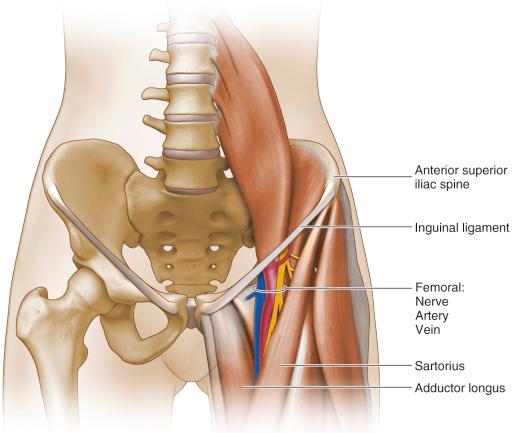
Laterally, the iliac crest can be traced from the ASIS arching posteriorly and ends posteriorly at the posterior superior iliac spine. The greater trochanter is an easily palpable lateral prominence and serves as the muscular insertion for the gluteus medius and minimus laterally, the piriformis, obturator internus, and gemelli posteromedially. The trochanteric ridge distally serves as the origin for the vastus lateralis muscle.
Posteriorly, the posterior superior iliac spine is easily palpable, and is often identifiable by a characteristic dimpling of the skin. The posterior superior iliac spine provides part of the origin of the gluteus maximus as well as the posterior sacroiliac ligaments ( Fig. 12.2 ). Inferior to the lower border of the gluteus maximus the ischial tuberosity can be palpated.
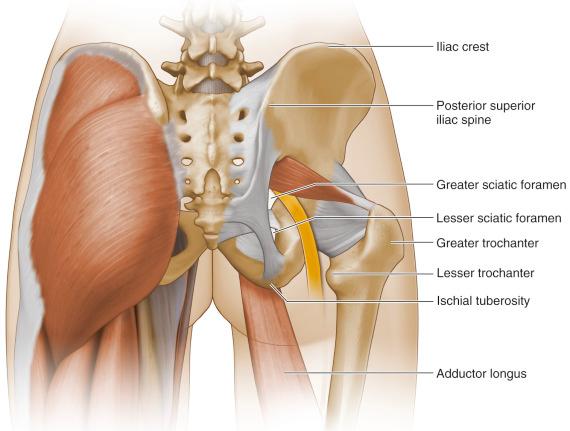
The hemipelvis is composed of the ilium, the ischium, and the pubis, which developmentally unite through fusion of the triradiate cartilage within the acetabulum. The ilium is the flattened superior portion of the pelvis with the superficial anatomy described previously. The greater sciatic notch is a major landmark on the ilium that is located posterior and superior to the acetabulum. The greater sciatic notch is an inverted U-shaped formation with contributions from the posterior ilium and lateral sacrum. The sacrotuberous and sacrospinous ligaments traverse the inferior margin of the notch creating the greater sciatic foramen ( Fig. 12.3 ). This foramen is a crucial anatomic structure allowing the passage of several key arterial, venous, and nervous structures from the pelvis into the perineum and thigh: the piriformis muscle, inferior gluteal nerve, superior gluteal nerve, posterior femoral cutaneous nerve, nerve to quadratus femoris muscle, and superior and inferior gluteal arteries and veins. The lesser sciatic foramen is formed by the sacrotuberous and sacrospinous ligaments and the ischial tuberosity. The obturator internus muscle, internal pudendal artery and vein, pudendal nerve, and nerve to the obturator internus muscle traverse this foramen. The ischium is an L-shaped bone that comprises the inferior portion of the pelvis. The sciatic buttress is the longitudinal, thick portion of the ischium that is critical in weight transfer of the axial skeleton, across the hip joint, to the lower appendicular skeleton. The pubis is composed of a body and a superior and inferior ramus. The rami in conjunction with the ischium form a window called the obturator foramen through which traverses the obturator nerve, artery, and vein. The bodies of the pubis articulate in the midline anteriorly at the pubic symphysis.
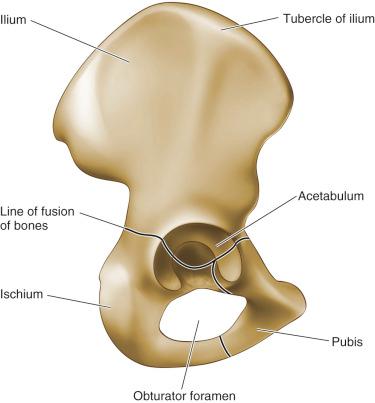
The acetabulum consists of a lunate-shaped articular region of hyaline cartilage and a central nonarticular fossa ( Fig. 12.4 ). From the inferior aspect of the fossa, the ligamentum teres carries the acetabular branches of the posterior division of the obturator vessels over to the fovea capitis, a small depression on the medial aspect of the femoral head. The acetabulum is deepened by the labrum, a fibrocartilaginous rim, which becomes the transverse acetabular ligament inferiorly as it bridges the cotyloid notch. It is theorized that not only does the labrum exert stability to the hip joint by providing depth to the articulation, but also adds additional stabilization through a suction mechanism with the femoral head.
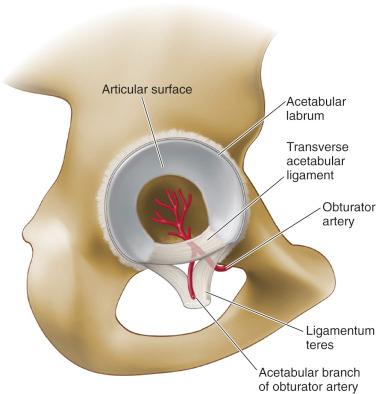
The acetabulum articulates with the femoral head in a ball-and-socket configuration and allows a wide range of motion. The joint is circumferentially enclosed by the hip capsule, which attaches to the labrum medially. Intimately associated with the capsule are ligaments that also surround the hip joint. Anteriorly, the hip joint is covered by an inverted Y-shaped iliofemoral ligament and the pubofemoral ligament ( Fig. 12.5 ). Posteriorly, both the iliofemoral and ischiofemoral ligaments attach the pelvis to the femur ( Fig. 12.6 ).
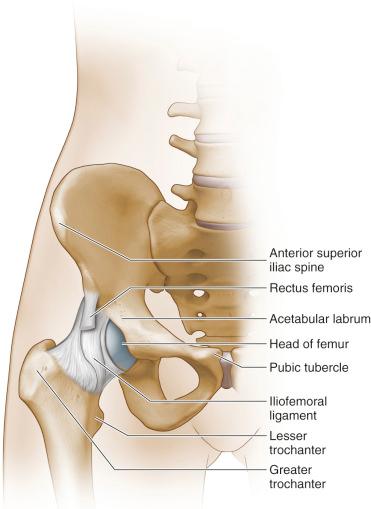
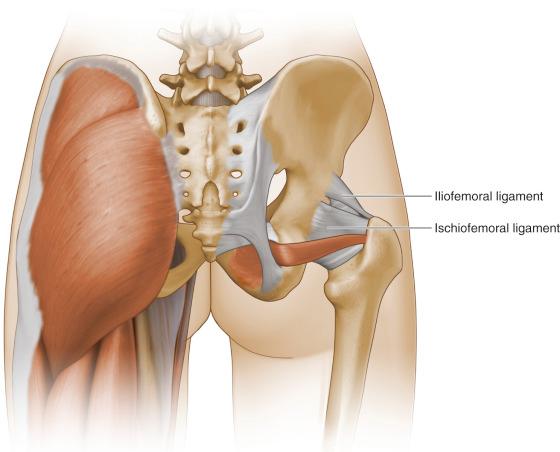
The femoral head tapers down to the femoral neck, which bridges the hip joint to the shaft of the femur ( Fig. 12.7 ). The neck shaft angle averages 127 degrees with anteversion averaging 14 degrees. The greater and lesser trochanters are prominences about the proximal femur that serve as attachment sites for various tendons and are connected by the intertrochanteric line. The femoral diaphysis has a gentle anterior bow as it extends distally toward the knee. Posteriorly, the diaphysis has a ridge called the linea aspera, which provides an attachment site for the adductor musculature in addition to the medial and lateral intermuscular septae.
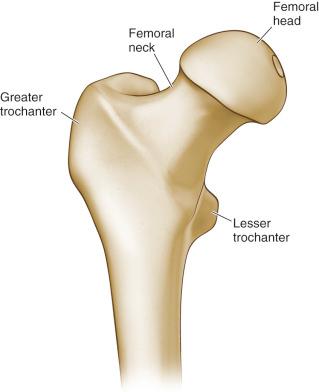
Become a Clinical Tree membership for Full access and enjoy Unlimited articles
If you are a member. Log in here